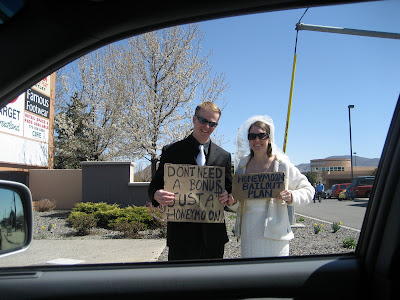The reason
This past Saturday, Bridget and I stopped off the freeway exit (near Plumb) and saw a young kid asking for money. He was dressed a bit scruffy, but you could see that he had just purchased some new shoes. We both shook our heads, and Bridget told me a story about how she worked with a person at a past job who would panhandle for more income. He had even told her that he would rather be begging for money rather than working since the money was better. As we drove a quarter mile, we saw what-most-likely-was the panhandler’s friend working the Costco parking lot. He was dressed similar – didn’t look homeless, but just looking for a handout. … And Bridget and I began to talk about an idea…
The Questions we had
Bridget and I wanted to test the following:
1. How much money is feasible for a panhandler to make?
2. Would people actually give money out to complete strangers who don’t even look like they need money?
3. How does it feel to be on the other side? How does it feel to ask for money on a street corner?
What we did
As a complete social experiment, Bridget and I decided to dress up as a couple who just got married. (Props to Bridget on this one…) Bridget dressed up in her wedding dress and veil. I grabbed a suit, and we made some signs asking for a honeymoon. We committed to standing on near the Neil and South Virginia corner, on the other side of David’s Bridal, for at least 60 minutes to see what would happen.

Our results
All in all, Bridget and I stayed a total of 75 minutes on the corner. We estimated about 500+ cars passed by in the lane next to us.
- For the most part, we received tons of dirty looks, WTF stares, and one person who yelled at us while he drove away
- We received $32 in total
– $22 from strangers (two separate people)
– $10 from Bridget’s parents - 3 honks for support
- 9 thumbs-up
- 8 waves
- One lunch offer
- A whole bunch of smirks, smiles, and laughs
Conclusion
Panhandling is no easy task. I felt extremely guilty for taking the first lady’s money. She told us about how she eloped with her husband and how expensive weddings can be. She then gave us $20 and she was super enthused to give us it. (I couldn’t believe it.) The second person gave us a few dollars, but I was still in awe about the first. Bridget’s parents gave us some pity money. I don’t think they believed that we were actually going to do it.
The Answers
1. A panhandler’s “wage” really depends on different things: location, appearance, what your sign says. I can’t imagine panhandling paying more than $20 per hour, but I’m positive people make more at this when they know what they’re doing. This was our first and last hour on the job, and we only made $11/hour.
2. Yes. People did give us money, and I think the reason may be the relativity. The $20 was given from a lady who eloped. Both of the people were younger. My assumption is that if people can somehow relate to you, they are more willing to give you money. (This is true for a lot of things.) Keep in mind, we didn’t look like we needed money and we weren’t begging for it; we just had cardboard signs that said we would accept money.
3. Panhandling is hard. The first five minutes into it, Bridget and I couldn’t believe what we were doing. People wanted to avoid you. They wouldn’t pull up all the way in their lane during a red light. They’d give you dirty looks and shake their head. Others tried not to look, which was obvious and a bit awkward. Panhandling is definitely something where you can’t feel guilty about getting handouts (we did) and you’ve come to terms with the wide array of people judging you, whether good or bad. Definitely, not for us.
Some people got that we were poking fun at our government and that we weren’t serious. They laughed and that made it worth it. So I was happy to see that we brightened up a few people’s day. And for the $32 that we received, that will be going towards a Unicef donation.
All in all, it was an interesting experience. It’s human to want to help people, especially those that are in need. But there’s no way to determine who needs it, and who wants it. I’ll keep on letting organizations figure that one out for me.
